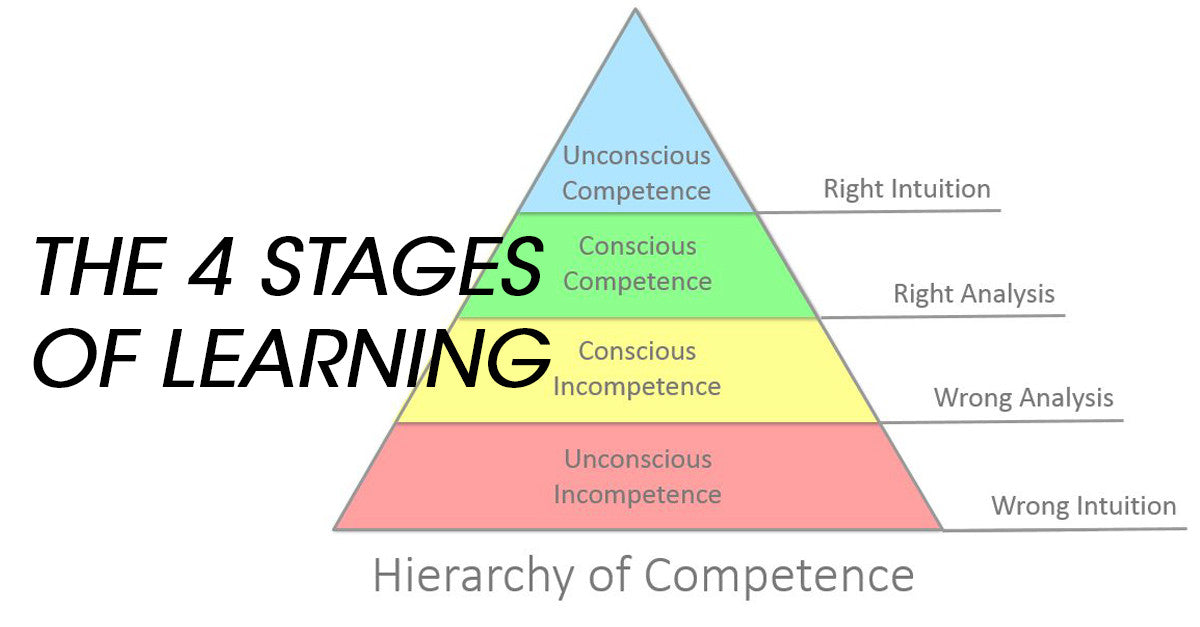The 4 Stages of Learning

Over the last decade of writing about Brazilian Jiu-Jitsu, much of my work has been dedicated to understanding how students can learn faster and how instructors can teach better. We all only have so much time to spend on the mats and we want to make the biggest strides we can.
That trend continues today because I want to talk about an idea from psychology that will help you at any stage in your BJJ journey. It is called the four stages of competence.
Per this learning model, you pass through these stages as you learn a skill:
- Unconscious incompetence
- Conscious incompetence
- Conscious competence
- Unconscious competence
Put another way, the stages of competence are:
- You do not know the skill exists, or if you do, you do not see the value of it.
- You knowing the skill exists, but you are bad at it. You see its value but are struggling to learn it. You could also know the skill exists but refuse to learn it.
- You know what you are doing but still having to concentrate to do it. You can perform the skill but need to focus.
- You know what you are doing so well that it comes naturally without much thought.
This model can be applied to any skill, but seeing as you are reading the Inverted Gear blog, we are going to use it to better understand what we go through as we learn BJJ.
For many old school grapplers, the original UFCs forced them out of stage 1 (unconscious incompetence) and into stage 2 (conscious incompetence). This was the first time the public saw ground fighting was real and could beat most of the martial arts world. They were faced with the choice of either seeking out grappling instruction or remaining willfully ignorant, like many traditional martial artists chose to do.
Many self-trained garage grapplers live in the bizarro zone between stages 1 and 2, wanting to know how to grapple but not being competent enough to see how bad they are, especially if they got “good” enough to beat up their untrained buddies. The Dunning–Kruger effect kicks in here, which is where someone feels a false sense of confidence because they are too incompetent to know how bad they really are.
The first time we roll is where many of us are shocked out of stage 1 and forced into stage 2. Some new students need this experience or they won’t see the value of BJJ. The job of the “gym enforcer” can be seen as smashing cocky new guys who are stage 1 until they become humble enough to enter stage 2 where the real learning can start. I’m not saying all noobies need to be smashed, but some guys are really asking for it, like those garage grapplers we just talked about.
As a beginner, you will spend your time in stage 2, feeling confused and overwhelmed. Accept this sense of frustration as normal and try not to stress out too much. This stage is about learning from mistakes. You need to try many wrong things so you can see why not to repeat them in the future. The struggle to get out of stages 1 and 2 into stage 3 is where most people quit (not counting all the people who do one class and never return). What’s funny is the white belts who look up to the blue belts do not realize those blue belts are struggling to climb out of stage 2 themselves.
Stage 3 is where things start to get fun. You know what you are doing, even if it takes some effort. This is where you can work to refine your skills. Getting to stage 4 is mostly about dedication, experience, and repetition. It just takes time.
Realize that these 4 stages can apply to specific skills. Even black belts will need to work through them again on neglected skills like takedowns, leg locks, or a newly developed guard. Leaving the comfort zone of your stage 4 skills can be hard but it is how new skills are acquired.
One of the valuable uses of this model to you as a student is that it gives you a way to put your experiences into perspective. Feeling frustrated and clumsy is a normal part of the learning process. Just keep working on it and you will get through it and into the next stage.
As a teacher, we can use this model to evaluate where our students are, both broadly, or in specific skill sets. Students may not take to learning a skill until its value is really demonstrated to them. This is where rolling with your students and using techniques from your curriculum on them can “sell” them on the need to practice what you teach -- or put another way, show them they were in stage 1 and push them into stage 2.
The 4 stages model gives us a clear picture of what it takes to improve any skill. If this was a new idea to you, I hope it helps you make sense of your journey. I would love to hear about any insights you gained from reading this in the comments below.
Graphic uses graph by Wikipedia user Kokcharov. Used under CC BY-SA 4.0.
Other articles:
Quick links
Contact us
About us
Quality BJJ gear at fair prices, available all year. Founded in 2012 to provide an alternative to high-cost, limited edition gis. Dive into the BJJ lifestyle with us—join the Panda Nation!"
